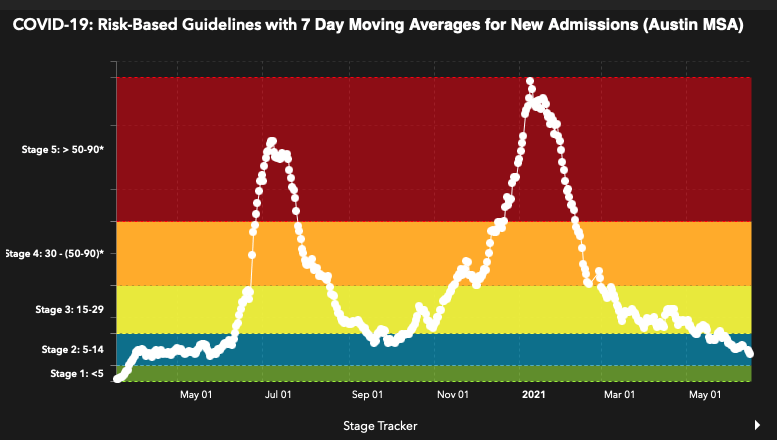Staged Alert COVID-19 System Linked to Shorter Lockdowns and Lives Saved
0 View
Share this Video
- Publish Date:
- 18 June, 2021
- Category:
- Covid
- Video License
- Standard License
- Imported From:
- Youtube
Tags

From June 16, Austin’s Staged Alert System. Credit: City of Austin
A phased alert system designed by scientists and public health officials to guide local policy helped a city avoid hospital spikes and lengthy lockdowns, according to new research published in the journal Nature Communications.
In a new study led by the University of Texas at Austin, COVID-19 Modeling Consortium in collaboration with Northwestern University, researchers describe the system that has guided COVID-19 policy in Austin, Texas, for more than a year, thereby protecting health. health care system and expensive measures. It tracks the number of new daily hospitalizations with COVID-19 and triggers changes in guidance when admissions exceed specific thresholds. While using this staged warning system, the Austin metropolitan area has the lowest per capita COVID-19 death rate of any major Texas city.
“Austin’s alert system is optimized to balance the city’s public health and socioeconomic goals,” said Lauren Ancel Meyers, professor of integrative biology and director of the COVID-19 Modeling Consortium at the University of Texas. “For more than a year, it has helped our community adapt to rapidly changing risks, protect the integrity of our hospital systems and mitigate economic damage.”
During the COVID-19 pandemic, policymakers struggled to fight COVID-19 while minimizing the social and economic impacts. Governments around the world have introduced several warning systems that trigger lockdowns when cases or hospitalizations reach critical levels. According to the paper, Austin’s system was better at avoiding overwhelming hospital spikes than the intensive care-based triggers used in France and better at avoiding lockdowns than Harvard Global Health’s much-cited recommendations.
“Our flexible methodology can design adaptive policies to fight COVID-19 globally and prepare for future pandemic threats,” said Meyers. “When we compared Austin’s optimized triggers to other similar alert systems, we found that it offers a much better balance between competing public health and economic targets.”
David Morton of Northwestern University designed the study with Meyers and Haoxiang Yang, a postdoctoral research associate at the Center for Nonlinear Studies (CNLS) at Los Alamos National Lab.
“The success of Austin’s system stems partly from its reliance on hospitalization data, which provide a more reliable signal of COVID-19 transmission than reported cases, and partly from our rigorous optimization of the alarm triggers,” Morton said. The researchers derived thresholds that gave a 95% guarantee that hospitals would not be exceeded.
The three hospital systems in the Austin area, Ascension Seton, St. David’s HealthCare, and Baylor Scott & White Health, provided key data not available in most other U.S. cities in the early months of the pandemic, including estimates for ICU and hospital capacity. and daily reports of new COVID-19 hospitalizations.
“The pandemic motivated a level of collaboration between the different health players in this community in a very special and effective way,” said Clay Johnston, dean of Dell Medical School at UT Austin. “Together, we created a system of triggers based on the latest local data, which was central to a coordinated response that helped prevent ICs from exceeding capacity and ultimately saved lives.”
“The Phased Alert System was developed by working with the hospital systems and members of the UT COVID-19 Modeling Consortium in Austin,” said Dr. Desmar Walkes of the Austin-Travis County Health Authority. “It is the result of a unique collaboration between city leaders, the three hospital systems and academics. This is proof that communicating behavior change is most effective when driven by science and data.”
Reference: June 18, 2021, Nature Communications.
DOI: 10.1038/s41467-021-23989-x
In addition to Chief Medical Officer Mark Escott, the Mayor of Austin, Steve Adler, Johnson, Meyers, Morton and Yang, the authors of the new paper are Özge Sürer, Daniel Duque, Bismark Singh, Spencer J. Fox, Rémy Pasco, Kelly Pierce, Paul Rathouz, Zhanwei Du and Michael Pignone.
This work was supported by the National Institutes of Health, the Texas Department of Human Services, the Centers for Disease Control and Prevention, CNSL, the Bavarian-Czech Academic Agency, and the Texas Advanced Computing Center at the University of Texas at Austin. The UT COVID-19 Modeling Consortium is made possible in part by the generous support of Tito’s Handmade Vodka. Meyers holds the Denton A. Cooley Centennial Professorship at the University of Texas at Austin.










